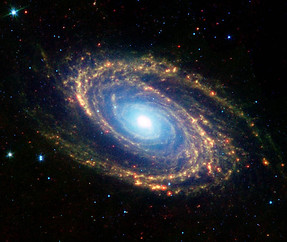Spiral galaxies are missing millions of years worth of collisions
Cosmologists who accept the Big Bang model naturally predicted that because spiral galaxies are, allegedly, at least hundreds of millions of years old, the large ones must have formed by mergers of smaller galaxies, so therefore the bulges in the center of the spirals would have formed from millions of years of collisions. However, astronomers carefully studying large spiral galaxies have found that 1) often there are no bulges at all, and 2) spirals exhibit a perfect orderliness in the trajectory of their stars. As reported in the New Scientist article, "Galaxies too good to be true," Princeton University cosmologist Jim Peebles added that, "It's really an embarrassment."
Cosmologist John Kormendy admitted that the pristine spirals, "were something of a shock." For they, "look rather too perfect." Yes, too perfect, like our DNA. Similar to evolutionary biology with its now falsified junk DNA prediction, the materialistic view of origins thinks it sees chaos even where order reigns.

Google: big bang predictions or evidence against the big bang, and see Real Science Radio's highly ranked articles at kgov.com. Carefully following this area of study, RSR hosts Bob Enyart and Fred Williams recommend two videos that highlight the important discoveries that contradict materialistic origins stories like the big bang. Spike Psarris, formerly with the U.S. military space program, created the greatest astronomy DVDs ever made, Vol. I about our Solar System, and Vol. II about Stars and Galaxies. Also, YoungEarth.com thanks Creation magazine for alerting us to the above spiral galaxy cluster findings. As reported for years on the RSR broadcast and podcast and as at rsr.org/list-of-shocked-evolutionists, those who believe in materialist origins are forever dismayed, shocked, and even call the latest discoveries "horrendous," because scientific observations typically contradict the fundamental predictions of atheistic origins.
The public's confidence is misplaced in the claim that scientists have figured out an atheistic origin of the universe, for in reality, even under their own theories that were devised in order to explain the formation of the universe, in moments of clarity they admit that they can't explain galaxies. Rather than having a robust theory that stepwise explains the origin of stars and galaxies, materialists cannot even say whether stars formed before galaxies, or whether galaxies formed before stars. John Maddox, physicist and 23-year editor of the journal Nature, admits on page 48 of his book, What Remains to be Discovered, that scientists don't even know, "Which objects came first, stars or galaxies?" Thus evolutionists oversell the evidence for the big bang to the public, and neither for Earth nor for space can they answer the chicken-or-egg dilemma. So while big bang cheerleaders like theoretical physicist (emphasis on the theoretical) Lawrence Krauss told us here at youngearth.com that, "All evidence overwhelmingly supports the big bang," the Albert Einstein professor emeritus of science at Princeton, Jim Peebles, said that the pristine star trajectories in the bulges, "is wildly unexpected in the standard model."
Here's the Point: Predictions are the hard currency of science. When the data contradicts big-picture predictions in an enormous way, as with galaxies-worth of contrary evidence from trillions and trillions of stars, the scientifically-minded student of nature will then reconsider the validity of the original model which led to the erroneous predictions, especially when this happens repeatedly. For more "shocking" discoveries from NASA and other big bang astronomy institutions, see the two other examples here at YoungEarth.com and see our RealScienceRadio.com/list-of-evidence-against-the-big-bang.


